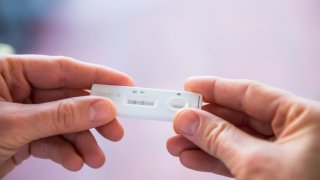
With COVID activity rising in the U.S. and in Illinois, many residents might be reaching for their at-home COVID tests, but there are some things you should know before you do.
As expected, XBB.1.5 has faded away in recent months and there is now a soup of different coronavirus variants causing illness and the most common ones are fairly close relatives.
Last month, the Illinois Department of Public Health reported wastewater testing indicated a rise in COVID activity in the state.
That's in line with a trend being seen across the U.S. As of data from Sept. 2, both hospitalizations and cases have continued to climb, with hospitalizations up 8.7% and cases up 10.5% in the most recent week.
As the so-called "mini-surge" continues its climb, while allergy season peaks and cold, RSV and flu seasons inch closer, many are searching for testing options.
So what should you know before you test?
Are your at-home tests still usable?
While many Americans may have unused tests in their homes, it's important to check the expiration dates, experts say.
The Food and Drug Administration has extended the expiration dates of many popular at-home test products, which means some such kits may still be safe to use, CNBC reports. You can check expiration dates for each brand using a page on the FDA's website.
When should you test?
Feeling out of the loop? We'll catch you up on the Chicago news you need to know. Sign up for the weekly Chicago Catch-Up newsletter.
Those who have symptoms are urged to take a COVID test as soon as possible, though officials continue to caution that a negative at-home test may not be as reliable as a positive one.
"If your antigen test is negative, take another antigen test after 48 hours or take a PCR test as soon as you can," the CDC states.
Those who don't have symptoms but may have been exposed should wait five days after exposure to take a test, according to the CDC guidance.
Some experts say you could test even earlier, but most recommend to continue testing through day five if those tests are negative.
“I would say the best rule of thumb is to start testing three days after exposure, and if you’re negative, test again on day four or five,” Dr. Michael Mina, a COVID testing expert and former professor of epidemiology and of immunology and infectious diseases at the Harvard T.H. Chan School of Public Health, told NBC News.
If I test negative does that mean I'm in the clear?
Those who were exposed and have symptoms are urged to continue testing for several days.
PCR tests can also pick up lower levels of the virus and would offer a more accurate determination for those looking for one.
The steps for what to do if you test negative can depend on symptoms, however.
If you have symptoms:
The FDA recommends "people who get an initial negative result on an antigen test, take at least one more test 48 hours later."
"Take a third test, 48 hours after the second, if the second test was negative and you don’t have symptoms. Self-tests are more likely to detect the virus if you have symptoms," the guidance states.
You may also want to consider contacting a healthcare provider to check for additional tests for other illnesses.
If you were exposed to someone with COVID-19, but don't have symptoms:
The CDC recommends if you test negative at least five days from your exposure that you repeat the test again 48 hours after your first test.
"If both tests are negative, then repeat testing after another 48 hours for a total of three tests," the guidance states.
What if you test positive? Does that mean you're contagious?
The answer is, "likely," especially with at-home tests,
According to the CDC, "self-tests detect current infection" and a positive result means "the virus was detected and you have an infection."
Do at-home tests work with the latest variants?
It is believe the at-home tests are still effective against the newer COVID variants.
“We’ve actually never seen a deterioration in accuracy of the tests, given any new variants,” Mina told NBC News. That’s because the mutations are happening in a different part of the virus than the portion detected by rapid tests. Almost every rapid test that’s authorized in the U.S. and globally detects a protein called the nucleocapsid, which is stable and just doesn’t, hasn’t seen a lot of mutations."
Most mutations so far have instead occurred in what is known as the spike protein.
Are COVID tests free?
Beginning on June 1, the government halted its free at-home test deliveries.
The tests are still available at many major pharmacies, and in some cases, insurance providers may reimburse you for the cost.
Walgreens, for example, has a form customers can use in which they will submit an insurance claim on your behalf.
But beyond the at-home test kits, lab PCR tests have become more challenging to access - and in some cases more expensive - since the national public health emergency ended in May.
Antigen and PCR testing is still available at major pharmacies, like Walgreens, for example, but out of pocket costs could apply, depending on your insurance provider.
You can also use the CDC's testing locator to see if there are any free testing sites near you.

